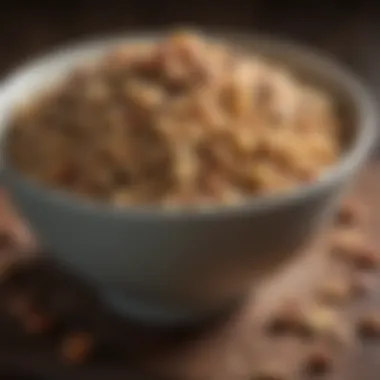Optimal Foods for Effective Weight Loss


Intro
In the quest for weight loss, understanding the role of specific foods can make a significant difference. This guide aims to deliver insights into nutrient-rich options that not only aid in shedding pounds but also promote overall health. By delving into the characteristics of various food groups and providing practical tips for incorporating them into daily routines, readers can gain clarity on making informed dietary choices. Beyond mere weight management, the discussion also encompasses physical and mental well-being enhancements, showcasing the wide-reaching benefits of optimal food selections.
Key Benefits
Physical Health Benefits
Choosing the right foods can lead to substantial enhancements in physical health. Nutrient-dense foods, such as leafy greens, lean proteins, and whole grains, play a vital role in maintaining energy levels and facilitating bodily functions. These foods are often low in calories yet high in important vitamins and minerals, making them excellent additions to any weight-loss diet.
For instance, foods rich in fiber, like oatmeal and legumes, can help in regulating digestion and keeping one feeling full longer. Additionally, incorporating healthy fats from sources such as avocados and nuts can support metabolic processes while preventing cravings. Ultimately, a well-balanced diet can diminish the risk of chronic diseases, such as heart disease and diabetes, enhancing long-term health and vitality.
Mental Well-being Enhancements
Weight loss does not solely involve physical transformation; it also encompasses psychological factors. Foods that are rich in omega-3 fatty acids, such as salmon and flaxseeds, have been shown to positively impact mood and cognitive functions. This can be particularly beneficial for individuals who may find the process of losing weight stressful or challenging.
Moreover, a diet high in fruits and vegetables can enhance mood due to their high antioxidant content, which can combat oxidative stress. Furthermore, maintaining stable blood sugar levels through balanced meals can help in reducing irritability and mood swings, fostering a more positive outlook during the weight-loss journey.
"A well-chosen diet contributes not only to physical health but to mental harmony as well."
Practical Tips
Effective Meal Planning
Meal planning is crucial when aiming for weight loss. Engaging in proactive planning can help in making better food choices and reducing the temptation to resort to quick, unhealthy options. Here are some strategies:
- Make a weekly menu: Outline meals for the week, ensuring a variety of nutrient-rich foods are included.
- Prepare meals in advance: Setting aside a few hours on weekends can yield ready-to-eat meals for the busy week ahead.
- Control portion sizes: Use smaller plates and bowls to ensure appropriate serving sizes, minimizing the potential for overeating.
Quick and Efficient Workouts
In addition to a healthy diet, incorporating regular exercise is paramount for successful weight loss. However, efficiency is vital for maintaining motivation. Short, high-intensity workouts can deliver significant results. Consider incorporating the following:
- Circuit training: This involves alternating between strength exercises with little rest, maximizing calorie burn in a short period.
- High-Intensity Interval Training (HIIT): Engage in short bursts of intense activity followed by rest periods to boost metabolism.
- Incorporate movement into daily life: Small changes, like taking the stairs or walking during breaks, contribute to overall activity levels.
By understanding the significance of food choices and their impact on both physical and mental health, individuals can navigate their weight-loss journey with greater clarity and effectiveness. Incorporating practical meal planning and efficient workouts further strengthens the path to achieving personal health goals.
Understanding Weight Loss and Nutrition
Understanding the interplay between weight loss and nutrition is crucial for anyone embarking on a journey towards a healthier body. This section lays the groundwork for comprehending how specific foods and nutrients affect weight management. A solid understanding leads to informed choices, which can enhance the effectiveness of any weight loss strategy. Nutrition is not merely about cutting calories; it is about making smart selections that nourish the body and promote sustainable habits.
The Science of Weight Loss
The science of weight loss revolves around the principle of energy balance. This concept posits that to lose weight, the body must expend more energy than it consumes. However, weight loss is multifaceted. It involves metabolic rate, hormones, and physiological responses to food intake. When individuals consume fewer calories than they burn, the body begins to utilize stored fat for energy. Understanding these mechanisms is vital for recognizing why certain diets work for some and fail for others.
Factors such as basal metabolic rate, which is the number of calories the body needs to maintain basic functions at rest, and thermogenesis, the heat production associated with food digestion and nutrient metabolism, interplay in this process. In addition, hormonal influences from foods, for instance, insulin and leptin, also play significant roles in how we store and utilize fat. Knowledge of these dynamics can help in planning effective weight loss strategies by taking advantage of the body's natural processes.
Importance of Nutrition in Weight Management
Nutrition is a cornerstone of effective weight management. It is not enough to focus solely on caloric intake. The quality of the food consumed significantly influences weight loss outcomes and overall health. A diet rich in whole, nutrient-dense foods is more likely to lead to successful weight loss compared to one that prioritizes low-calorie processed foods.
Nutrients such as fibers, protein, vitamins, and healthy fats are critical. For instance, fiber aids in digestion and creates a feeling of fullness, helping to control appetite. Proteins are vital for muscle maintenance, which is particularly important when losing weight to prevent muscle loss. Healthy fats, found in avocados or nuts, can help with satiety and prevent the craving for unhealthy snacks.
In sum, a comprehensive understanding of how nutrition affects weight management leads to better decisions that not only promote weight loss but also encourage long-term health and well-being.
"Choosing the right foods is as important as knowing how much to eat. Both aspects benefit from a well-informed approach to nutrition."
By grasping these concepts, individuals can develop a balanced meal plan tailored to their unique needs, setting the stage for sustained weight loss.


Macronutrients Essential for Weight Loss
In the journey of weight loss, understanding macronutrients is crucial. Macronutrients are the nutrients that provide energy and are essential for bodily functions. They include carbohydrates, proteins, and fats. Each serves different purposes and contributes to the overall effectiveness of a weight-loss strategy. Recognizing how to balance these macronutrients can significantly influence success in weight management.
Carbohydrates: Good vs. Bad Choices
Carbohydrates are often misunderstood in the context of weight loss. They are a primary energy source, but not all carbs are created equal. Complex carbohydrates, like whole grains, legumes, and vegetables, are rich in fiber and beneficial for digestive health. They provide sustained energy and help prevent hunger.
Conversely, simple carbohydrates, such as those found in sugary snacks and beverages, can lead to energy spikes and crashes. These processed carbs lack nutrients and do not promote satiety. It is essential to focus on choosing good carbohydrates. Include foods like quinoa, oats, and sweet potatoes in your diet while reducing intake of white bread, pastries, and sugary drinks.
Proteins: Role in Satiety and Muscle Maintenance
Protein is often highlighted for its role in muscle maintenance during weight loss. However, its contributions to satiety are equally notable. High-protein foods can increase feelings of fullness, reducing overall calorie intake. When incorporating protein, opt for lean sources. Chicken breast, fish, and legumes are excellent options.
Research indicates that consuming adequate protein while losing weight can preserve lean muscle mass. This is vital since muscle tissue burns more calories than fat, even at rest. Therefore, protein intake should not be neglected; structure meals around protein-rich foods to aid in both weight loss and muscle preservation.
Fats: Healthy Fats for Weight Loss
Fats also play a key role in a balanced diet. It is a common misconception that all fats should be avoided during weight loss. Instead, focusing on healthy fats is essential. Monounsaturated fats found in foods like avocados, olive oil, and nuts can promote heart health and contribute to weight loss.
Including healthy fats in moderation can enhance the feeling of fullness and provide essential fatty acids, which the body cannot produce itself. Fatty fish like salmon offer omega-3 fatty acids that are beneficial for overall health. When planning meals, integrate these healthy fats as part of a varied and balanced diet.
Key Point: Balancing carbohydrates, proteins, and healthy fats properly can optimize weight loss progress, ensuring that your nutritional needs are met without compromising satisfaction.
Understanding these macronutrients allows individuals to make informed choices that not only support weight loss but also contribute to overall health. Thoughtful consideration of what to consume is imperative for achieving long-term sustainability in weight management.
Nutrient-Dense Foods to Consider
Nutrient-dense foods are critical for anyone seeking to lose weight effectively. These foods provide essential vitamins and minerals while being lower in calories. As a result, they can help maintain energy levels and promote overall health. Choosing nutrient-dense options is an effective strategy for achieving long-term weight loss goals. This section explores the different categories of these foods, focusing on their unique properties and benefits.
Vegetables: A Foundation of Weight Loss
Vegetables are a key component of nutrient-dense diets. They are low in calories and high in fiber, making them excellent for weight loss. Including a variety of vegetables in meals can improve satiety and reduce overall caloric intake.
Leafy Greens
Leafy greens such as spinach, kale, and Swiss chard are low in calories yet high in nutrients. They are rich in vitamins A, C, and K, along with minerals like calcium and iron. The high fiber content helps one feel full without the extra calories. Including leafy greens in meals increases nutrient intake without contributing to weight gain.
Cruciferous Vegetables
Cruciferous vegetables like broccoli, cauliflower, and Brussels sprouts are known for their cancer-fighting properties. They contain compounds that may help reduce inflammation. Their high fiber content also aids digestion and promotes satiety, making them a popular choice for those looking to lose weight. Including these vegetables can enhance the nutritional profile of any meal.
Root Vegetables
Root vegetables such as carrots, sweet potatoes, and beets are nutrient-dense and offer many vitamins and minerals. They provide carbohydrates while maintaining lower caloric values. Their natural sweetness can satisfy cravings for snacks or sweets. When compared to other starchy foods, root vegetables provide fiber and essential nutrients, making them sound choices.
Fruits: Natural Sugars and Fiber
Fruits are another category of nutrient-dense foods packed with vitamins, antioxidants, and fiber. They offer natural sweetness, helping to satisfy cravings without excessive calories. Adding fruits to meals enhances flavor while providing health benefits.
Low-Calorie Fruits
Low-calorie fruits like watermelon, strawberries, and cantaloupe contain high water content and can be filling. These fruits provide essential vitamins while keeping calorie counts low. Their natural sugars can satisfy sweet cravings without the downside of added sugars. They are wonderful snacks or additions to salads, maintaining flavor without excess calories.
Berries and Antioxidants
Berries such as blueberries, raspberries, and blackberries are rich in antioxidants which combat oxidative stress and inflammation. Additionally, they are high in fiber, which contributes to satiety. Including berries in diets not only adds flavor but also supports overall health and may aid in weight management.
Citrus for Hydration


Citrus fruits like oranges, grapefruit, and lemons are known for their hydrating properties. They are also good sources of vitamin C. The high water and fiber content promote fullness, making them effective for weight loss goals. Optionally, using citrus juice or zest can enhance flavors in many dishes without adding calories.
Whole Grains: Complex Carbs for Energy
Whole grains are essential for providing energy while being nutrient-rich. They contain more fiber than refined grains and contribute to a feeling of fullness, which helps in weight control. Whole grains also provide important nutrients like B vitamins and minerals.
Oats and Barley
Oats and barley are both high in soluble fiber, which can help lower cholesterol levels and promote heart health. They digest slowly, which contributes to sustained energy levels throughout the day. Their use in breakfast and other meals can help stabilize blood sugar levels, making them beneficial for weight loss.
Quinoa and Brown Rice
Quinoa and brown rice are excellent sources of protein compared to other grains. They provide essential amino acids while also being high in fiber. They serve as versatile base ingredients for various dishes, ensuring nutrient-dense meals that support weight loss.
Whole Wheat Products
Whole wheat products, including bread, pasta, and cereals, are rich in fiber and help in maintaining digestive health. They have a lower glycemic index than refined wheat products, which means they provide longer-lasting energy without causing spikes in blood sugar. Including whole wheat options in diet supports weight loss efforts effectively.
Lean Proteins: Building Blocks of Muscle
Lean proteins are essential for maintaining muscle while losing weight. They help build and repair tissues, making them vital in any weight loss plan. Protein also contributes to satiety, which prevents overeating.
Chicken and Turkey
Chicken and turkey are popular choices for their low fat and high protein content. They deliver essential amino acids that aid in muscle recovery and growth. These lean meats are versatile, making it easy to incorporate them into various meal plans.
Fish and Seafood
Fish and seafood like salmon, tuna, and shrimp are high in omega-3 fatty acids. These are known to promote heart health and reduce inflammation. Being protein-rich, fish supports muscle maintenance while keeping calorie intake lower than red meats. This makes them a highly recommended option for anyone pursuing weight loss.
Plant-Based Proteins
Plant-based proteins, including beans, lentils, and chickpeas, are healthy alternatives to animal protein. They are rich in fiber yet provide high protein content. These foods are great for vegetarian or vegan diets, promoting satiety and health without excess calories.
Healthy Fats: Balancing Nutritional Needs
Healthy fats are an important part of a nutrient-dense diet. They play various roles in metabolic processes and contribute to overall health while supporting satiety.
Avocados and Olives
Avocados and olives are known for their monounsaturated fats, which are beneficial for heart health. They provide essential nutrients while reducing inflammation. Their creamy texture and flavor add richness to meals, making them enjoyable choices in moderation.
Fatty Fish like Salmon
Salmon and other fatty fish are rich in omega-3 fatty acids, promoting brain health and reducing heart disease risks. They are also an excellent source of protein, making them satisfying and nutritious. Including fatty fish regularly can contribute positively to weight loss efforts.
Nuts and Seeds
Nuts and seeds are packed with healthy fats, protein, and fiber. They offer a good balance of nutrients, making them convenient snacks. However, due to their higher calorie density, portion control is essential while incorporating them into a weight loss diet. Choosing a variety of nuts and seeds can enhance overall nutrition while still supporting weight loss goals.
Incorporating Foods into Your Diet
Incorporating beneficial foods into your daily diet is essential for achieving and maintaining weight loss. This process requires understanding not only what foods are optimal for your health but also how to effectively include them in realistic, everyday meals. Making considered food choices plays a pivotal role in ensuring that your body obtains valuable nutrients while managing caloric intake. Successful incorporation is a blend of strategizing meals, being aware of mindful eating, and making wise choices when it comes to snacks.
Meal Planning Strategies
Meal planning is a fundamental strategy for promoting healthy eating habits. By organizing meals in advance, you can avoid last-minute, less healthy options that often come with convenience eating. A good meal plan considers various factors such as personal dietary preferences, nutritional needs, and portion sizes. Here are some effective strategies for meal planning:


- Create a Weekly Menu: Allocate specific foods to each day based on balance and variety. This encourages you to include a range of nutrients.
- Make a Shopping List: Writing down the ingredients you need prevents impulse purchases while grocery shopping. Focus on whole foods and limit processed items.
- Prep in Batches: Preparing several portions of healthy recipes can save time and ensure you have nutritious meals ready to eat, which reduces reliance on less healthy alternatives.
By implementing these strategies, you streamline the process of maintaining a diet that aligns with your weight loss goals.
Mindful Eating Practices
Mindful eating involves being fully present during meals and paying attention to the eating experience. This practice is essential for fostering a healthy relationship with food and can significantly impact weight loss efforts. Important elements of mindful eating include:
- Listening to Hunger Cues: Recognizing true hunger signals rather than eating out of boredom or stress can help in regulating portions.
- Savoring Each Bite: Taking time to chew food properly and appreciate its flavors promotes satisfaction with smaller portions.
- Limiting Distractions: Eating while focusing on screens or multitasking can lead to overeating. Instead, create a designated eating space that diminishes distractions.
Mindful eating cultivates awareness and intentionality, making it easier to enjoy food while managing caloric intake.
Snacking Wisely
Snacking is often a neglected aspect of healthy eating, but it can play a critical role in weight management if approached thoughtfully. The key is to choose snacks that adhere to the principles of nourishment rather than indulgence. Here are some guidelines for snacking wisely:
- Opt for Nutrient-Dense Options: Snacks should be rich in fiber, protein, or healthy fats. Examples include Greek yogurt, fresh fruits, vegetables with hummus, or a handful of nuts.
- Watch Portion Sizes: Even healthy snacks can lead to excess calories if consumed in large amounts. Pre-portioning snacks can aid in controlling intake.
- Be Mindful of Timing: Choosing to snack between meals can prevent overeating at mealtimes. However, consider the quality of the snacks to ensure they support your nutritional goals.
Taking the time to select and prepare snacks with intention helps maintain energy levels and control hunger throughout the day.
"Incorporating thoughtful strategies into your eating habits can set a strong foundation for sustainable weight loss journeys."
Effective incorporation of foods into your diet is a multifaceted approach. When combined with a clear understanding of nutritional needs, these practices can significantly enhance the likelihood of achieving weight loss goals.
Common Pitfalls and Myths about Food Choices
Navigating the complex world of diets can be daunting. In this section, we will address common pitfalls and myths surrounding food choices. Understanding these issues is crucial for anyone looking to lose weight effectively. Knowledge empowers individuals to make informed decisions, avoiding mistakes that could derail progress. Misconceptions and poor choices can lead to frustration, a lack of motivation, or unhealthy eating habits.
Debunking Weight Loss Myths
Myths about weight loss abound, often complicating genuine efforts to shed pounds. One prevalent myth is the notion that skipping meals helps in weight loss. In reality, this practice can lead to overeating later in the day, as hunger may push individuals to consume more calories than if they had eaten regularly.
Another common myth is that all carbohydrates are detrimental to weight loss. In contrast, complex carbohydrates—such as those found in whole grains or vegetables—provide necessary energy and can aid satiety. It’s important to differentiate between types of carbs rather than adopting blanket statements.
Furthermore, the idea that certain foods can cause weight loss merely by adding them to a diet, like grapefruit or cabbage soup, lacks scientific backing. Weight loss ultimately hinges on a caloric deficit, not solely on incorporating specific items.
Avoiding Processed Foods
Processed foods pose a significant barrier to achieving weight loss goals. These foods often contain high levels of sugar, sodium, and unhealthy fats, which can lead to weight gain. Meals loaded with preservatives and artificial ingredients can also disrupt healthy digestion.
To effectively lose weight, it's wise to limit processed food intake. Instead, focus on whole, nutrient-dense foods that support metabolic health. Civilians often think choosing "diet" products is a smart move, but these items can be deceptively high in calories and sugar, undermining weight loss efforts.
Opting for fresh fruits, vegetables, and lean proteins is better for nourishing the body and supporting sustainable weight loss. It's beneficial to read labels carefully and look for shorter ingredient lists.
Key Takeaway: Dispel myths around food choices while focusing on whole, unprocessed foods. Prioritizing these will lead to more effective weight management.
By addressing these aspects, individuals can better navigate their weight loss journeys. Understanding common pitfalls and debunking myths can lead to a more mindful and successful approach to nutrition.
Culmination
The conclusion of this comprehensive guide is essential for synthesizing the plethora of information presented on optimal foods for weight loss. It serves as a pivotal moment where readers can reflect on how these foods, strategies, and concepts intersect to form an effective weight management regimen. Understanding the importance of nutrients, food choices, and mindful eating practices is paramount for anyone seeking not just to lose weight but to maintain a balanced lifestyle.
One cannot underestimate the role of nutrient-dense foods in a sustainable weight-loss journey. These foods not only assist with reducing caloric intake but also provide essential vitamins and minerals that optimize bodily functions. By highlighting the significance of meal planning and mindful eating, this guide encourages a holistic view of nutrition, which promotes long-term health benefits beyond weight loss. Hence, engaging with this information empowers readers to make informed decisions that align with their health goals.
Summary of Key Points
- Nutrient-Dense Foods: Prioritizing vegetables, fruits, whole grains, lean proteins, and healthy fats can aid in effective weight management.
- Macronutrient Balance: Understanding carbohydrates, proteins, and fats helps in making better food choices that support weight loss strategies.
- Meal Planning and Mindfulness: Strategic meal planning and practicing mindfulness during meals can prevent overeating and improve overall satisfaction with food.
- Debunking Myths: It is crucial to dispel common myths surrounding weight loss and food, especially the tendency to cut out entire food groups unnecessarily.
- Sustainability: Opting for foods that one enjoys and can continue to consume offers lasting benefits and aids in maintaining weight loss.
Encouragement for Sustainable Choices
To achieve success in weight loss endeavors, it's important to approach dietary changes with a focus on sustainability. This guide provides a framework, but the true power lies in individuals making choices that resonate with their personal preferences and lifestyle.
Encouraging sustainable food choices means embracing flexibility while striving for a balanced diet. Integrating occasional indulgences can reduce feelings of deprivation, which often lead to setbacks. Remember, it's not just about short-term results but about fostering habits that are achievable over a lifetime.
When making choices, consider not just the immediate effects but also long-term impacts on health and well-being. Foods that are nutrient-dense not only promote weight loss but also enhance overall vitality. By treating nutrition as a lifelong journey rather than a quick fix, individuals can cultivate a positive relationship with food that supports both their physical and mental health.















